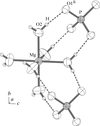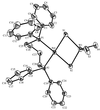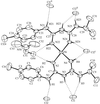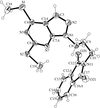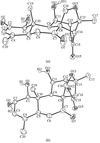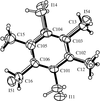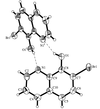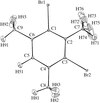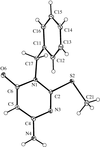issue contents
August 2003 issue

Cover illustration: A view of the structure of ![[mu]](/logos/entities/mu_rmgif.gif) 4-oxo-tetrakis(
4-oxo-tetrakis(![[mu]](/logos/entities/mu_rmgif.gif) -2,2,6,6-tetramethylpiperidinido)dimagnesium(II)disodium(I), a new Na/Mg inverse crown ether. Ellipsoids are shown at the 50% probability level and H atoms have been omitted for clarity. See Kennedy, MacLellan & Mulvey [Acta Cryst. (2003), C59, m302-m303].
-2,2,6,6-tetramethylpiperidinido)dimagnesium(II)disodium(I), a new Na/Mg inverse crown ether. Ellipsoids are shown at the 50% probability level and H atoms have been omitted for clarity. See Kennedy, MacLellan & Mulvey [Acta Cryst. (2003), C59, m302-m303].
inorganic compounds
Download citation


Download citation


The main building block of the crystal structure of monoclinic [UO2(NO3)2(H2O)2]·H2O is the finite non-centrosymmetric [UO2(NO3)2(H2O)2] cluster, which is a uranyl hexagonal bipyramid that shares two non-opposite equatorial edges with the nitrate triangles, such that the two water molecules are at neighbouring equatorial vertices. There is an interstitial water site in the structure, which is located between adjacent [UO2(NO3)2(H2O)2] clusters.
Download citation


Download citation


The title microporous material, (K,Li)-(Al,Ge)-GIS, namely lithium potassium dialuminium digermanium octaoxide dihydrate, is the result of a 50% Li+ exchange into the K-(Al,Ge)-GIS structure. A structural change occurs due to disordering of K+ ions with Li+ ions along [001] and ordering of water molecules along [101].
Download citation


Download citation


Manganese antimony diselenide iodide is a distorted variant of the UFeS3 structure. The structure contains layers parallel to the bc plane that consist of edge- and corner-sharing MnSe6/2 and MnSe2/2I4/2 octahedra. Sb atoms are located between these layers and form SbSe3 trigonal pyramids.
Download citation


Download citation


The refinements of two modifications of an adduct of potassium dihydrogenphosphate and hydrofluoric acid were performed on data collected at 250 and 150 K, and at 292 and 150 K. Both modifications contain a very short F—H⋯O hydrogen bond. The modifications differ in the arrangement of the dihydrogenphosphate anions and the hydrogen-bonding schemes.
Download citation


Download citation


A new cubic form, in space group F 3m, of Cs[Mg(H2O)6](PO4) has been found and is isostructural with the analogous arsenate. [Mg(H2O)6]2+ cations and phosphate anions are connected by hydrogen bonds, forming a sphalerite-like three-dimensional framework.
3m, of Cs[Mg(H2O)6](PO4) has been found and is isostructural with the analogous arsenate. [Mg(H2O)6]2+ cations and phosphate anions are connected by hydrogen bonds, forming a sphalerite-like three-dimensional framework.
Download citation


Download citation


The room-temperature structure of the B-site-ordered complex perovskite dicalcium magnesium tungstate, Ca2MgWO6, has been determined by simultaneous Rietveld refinement of neutron and X-ray powder diffraction patterns. Ca2MgWO6 is characterized by B-site ordering and an a−a−c+-type BO6 octahedral tilt mechanism.
metal-organic compounds
Download citation


Download citation


Download citation


Download citation


Download citation


Download citation


Download citation


Download citation


Download citation


Download citation


Download citation


Download citation


Download citation


Download citation


Download citation


Download citation


Download citation


Download citation


Download citation


Download citation


Download citation


Download citation


Download citation


Download citation


Download citation


Download citation


Download citation


Download citation


organic compounds
Download citation


Download citation


Download citation


Download citation


Download citation


Download citation


Download citation


Download citation


Download citation


Download citation


Download citation


Download citation


Download citation


Download citation


Download citation


Download citation


Download citation


Download citation


Download citation


Download citation


Download citation


Download citation


Download citation


Download citation


Download citation


Download citation


Download citation


Download citation


Download citation


Download citation


Download citation


Download citation


Download citation


Download citation


Download citation


Download citation


Download citation


Download citation


Download citation


Download citation


Download citation


Download citation


Download citation


Download citation


Download citation


Download citation




 journal menu
journal menu















